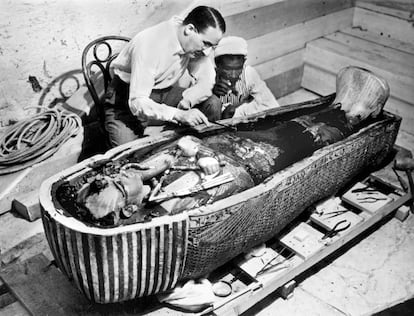We already have a novel for this year of the centenary of the discovery of Tutankhamun's tomb, which takes place next November.
It is
The Conspiracy of the Valley of the Kings
, and it does not come in English from the Anglo-Saxon world but in Spanish and has just been published by La Esfera de los Libros in its collection of historical novels.
Its author is Luis Melgar (Madrid, 41 years old), who last year published in the same publishing house
La peregrina de Atón
, a novel about the time of Amarna (the same as the young pharaoh) that attributed a
queer
identity to Akhenaten.
In
The Valley of the Kings Plot
It really embroiders a sensational pastiche, perfectly documented, set at the time of the most famous find in the history of archaeology.
Melgar gathers around the story of the discovery, which he tells very, very well, its protagonists, Howard Carter, Lord Carnarvon and his daughter Evelyn (part narrator), and a whole gallery of contemporary historical figures such as Lawrence of Arabia, occultist Aleister Crowley, Sir Arthur Conan Doyle, Lord Curzon, Oswald Mosley, Arthur Weigall, Egyptian nationalists, mediums and spiritualists, Fabians,
suffragettes
, the Prince of Wales and even the Duke of Alba.
Even the famous Bad Luck Mummy comes out!
The special grace of the matter is that it turns the story of the search and discovery in 1922 of Tutankhamun's tomb into a crime novel, with direct homage to Agatha Christie.
She, with her archaeological connections (she married archaeologist Max Mallowan and accompanied him on her digs), would no doubt have liked it.
More information
'Queer' Akhenaten and his transgender sister-in-law
The victim is Carnarvon, Carter's employer and patron of his excavation, whose death in 1923 due to an infected mosquito bite presents, according to Melgar, enough loopholes to begin to imagine that he could have been murdered.
His daughter, Lady Evelyn, is in charge in the novel of investigating, like Poirot or Miss Marple, the possible motives for the crime (political, sentimental, economic, esoteric), following the clues and, in a literary clue, finding the culprit. among the many suspects.
What might seem like nonsense, approaching the story of the great discovery this anniversary year from the crime novel, turns out to be a very happy idea, especially due to the conscientious way in which the author has elaborated the plot and the way it is so entertaining. account.
The Valley of the Kings conspiracy
is an excellent way to immerse yourself in the story of the find and, despite being a work of fiction (and showing scenes as surprising as Howard Carter in an orgy, in a seance with Conan Doyle , on a camel to Siwa or blackmailed by some compromising photos), discover many things about that archaeological event and the real personalities of its protagonists.
In particular, the difficult character of Carter, the discoverer, and his relationship of subordination at work and at the same time his friendship with Lord Carnarvon are very well described.
Melgar's account of that friendship with ups and downs is moving and fits extraordinarily well with what we know from biographers and historians (see, for example, the referenced biography
Howard Carter, the Path to Tutankhamun
, by TGH James, Kegan Paul International, 1993).
"There is something strange about Carnarvon's death," says Luis Melgar, who has traveled to Barcelona with her husband to embark on a Mediterranean cruise, in the bar of the Majestic hotel, a setting that is not the Winter Palace in Luxor but the lord would have liked.
The writer has surprised (and even alarmed) by appearing with a bandage on his right hand, the one for writing, which suggests Tutankhamun's curse, to which, as he was forced, mention is made in the novel;
but it is that they have operated on the carpal tunnel.
The bandage will be removed for the photo at the neighboring Egyptian Museum, which is a shame because it gave him a mummy point.
“I think there is something fishy about that death,” he continues, speaking of Carnarvon.
"Of course nothing esoteric, but there are many coincidences,
especially the coincidence of the discovery of the tomb with the independence of Egypt, that same year, and the turbulence that it caused.
Suddenly everything changed in the relationship with foreign archaeologists, and for Egyptian-British relations the tomb of Tutankhamun and Carnarvon's heritage sense of it were a nuisance when the important problem was the Suez Canal.
I have mixed the finding with the political situation and that opens up a lot of perspective.
There was a lot of concern in the British Government because the issue of Tutankhamun's tomb was hindering the relationship with Egypt;
the find was very untimely.”
A conspiracy, then?
“The official version of the sting seems very bizarre to me.
And Carnarvon, with his claim to the tomb at such a delicate moment, was a very uncomfortable character whom, as a peer of the Realm,
they couldn't shut up or drive like Carter.
In any case, mine is a novel, of course, and that gives you total license”.
Lord Carnavon, the victim in Melgar's novel Personalities (TopFoto.co.uk / Cordon Press)
The author shows great skill when it comes to mixing archeology and international relations, as well as showing the environment in political and diplomatic circles, it is not for nothing that he is a diplomat himself (currently, first secretary of the Spanish embassy in China) .
He particularly enjoys describing the atmosphere at Highclere Castle, the Carnarvon estate (where
Downton Abbey was filmed),
and the gossip and bed-fights of the aristocracy (in the novel, Carnarvon and the Prince of Wales share a lover, and Carter's house near the Valley of the Kings is used by the lord as a riding arena).
Melgar also suggests that the tomb may have been found earlier.
“There's a lot of my vintage in the novel, but it's true that it's rare for Carter to find the grave just as Carnarvon is about to turn off the tap.
Did Carter already know where he was? Where did he get the absolute conviction that there is an intact tomb in the Valley of the Kings?
There were indications, yes, but I do not rule out that Carter, who was very involved in Egyptian society, had local information, and that the Egyptians were waiting for the English to leave to dig up the grave.
Finally, all its contents remained in Egypt, which had not happened until then, inaugurating a new era of relationship between the country of the Nile and its heritage.
“The most logical thing, and what everyone expected then,
is that a good part of Tutankhamun's grave goods ended up in the British Museum in London or the Metropolitan in New York.
If you think about it, Tutankhamun's treasures, like his golden mask, are among the few great pharaonic icons that have remained in Egypt, unlike the Rosetta stone, the seated scribe or the bust of Nefertiti”.
Howard Carter examines the sarcophagus of Tutankhamun, in 1922. Rue des Archives (Getty Images)
Today we know that Carter and Carnarvon stole a few things for their private collections.
“Yes, I have not touched on the subject in the novel, because it was already too much, but it is true that there are some objects in the tomb that are not in Egypt.
Both, especially the lord, who paid the concession, considered what they found their own, it was typical of the time.
You don't have to judge them from the present.
They were perplexed by the change in the usual distribution regulations, which did not grant them anything.
The complex character of Carter, who is continually made by Melgar to recite the titles of Tutankhamun to himself as a reassuring litany, is portrayed very convincingly.
“He is the one that has interested me the most, it seems that he suffered from a condition close to autism, in addition to a repressed sexuality.
He often felt slighted, left out, and rejected, causing him to get into fights with everyone.
He especially hated tourists and journalists.
He was looking for recognition and he didn't get it.
Making the greatest archaeological discovery in history did not help him rise socially or be given a noble title, something that he undoubtedly deserved and would have been awarded today.”
Melgar acknowledges that there is no direct proof of Carter's homosexuality, "although apparently in his environment it was known that he was";
in any case,
He describes him as a repressed and prudish homosexual, who is disgusted to be touched, "and from all this derives his great tension."
The novelist points out that "now Carter would have had an easier time fitting in."
A guard from the tomb of Tutankhamun observes the burial chamber of the enclosure, with the pharaoh's sarcophagus.
MOHAMED EL-SHAHED (AFP)
Luis Melgar has had a wonderful time incorporating it into his plot, in a fertile
crossover
literary, to historical figures who may or may not have been related to each other.
“There is no evidence that Carter and TE Lawrence knew each other, but Lawrence was an archaeologist and during World War I, Carter served with British Military Intelligence in Cairo, so they could very well have met.
The same with the disturbing Crowley and with others that appear.
I'm not making up James Fitz-James Stuart, who met Carter and Carnarvon and visited Tutankhamun's tomb with his daughter, the Duchess of Alba.
I have loved fitting the pieces, real and invented, into the novel, putting the puzzle together”.
The author finds it amusing that some readers consider what is real invented and vice versa, such as the cases of the famous yellow canary and the cobra (true), and the scorpion that stings Carnarvon (false).
Carter, Carnarvon and their daughter, recreated by actors in the television series 'Tutankhamun'.
The novelist declares himself a great admirer of Agatha Christie and in his novel there are several tributes, one directly to
Murder on the Orient Express,
although he turns it around.
In
The Conspiracy of the Valley of the Kings,
which takes time jumps in different years between before and after the discovery of the tomb, the episode of the discovery, the
Tutankhamun moment , is described with great precision and emotion.
, including that Carter, Carnarvon, and Evelyn (reportedly infatuated with the archaeologist) wandered through the entire tomb before the official opening.
“It was hard for me to write something that has been told so many times, I was lazy, but I couldn't not put the discovery and the 'wonderful things'.
In fact, the plot of the conspiracy has allowed me that the discovery —an anticlimax because everyone already knows what happened, that they found the tomb and what was inside— is not the central point of the novel”.
Between excavations, plots, sex, friendship, mystery, pharaonic antiquities and a lot of adventure, Melgar writes such evocative things as this: "The sun had already set and an orange glow enveloped the valley, as if the desert sand had turned into gold dust".









